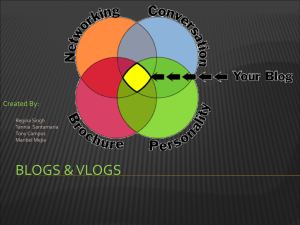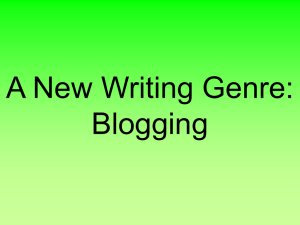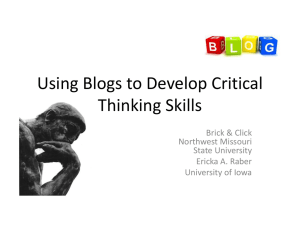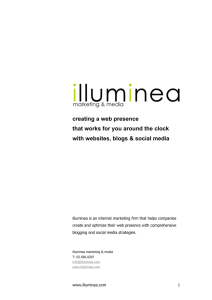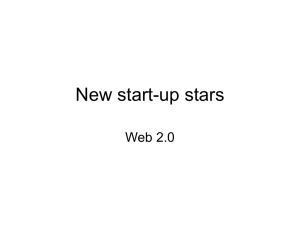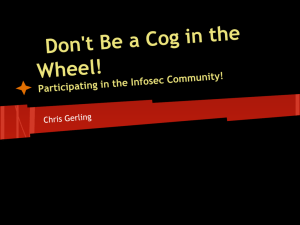PPT - ACS Division of Chemical Information
advertisement
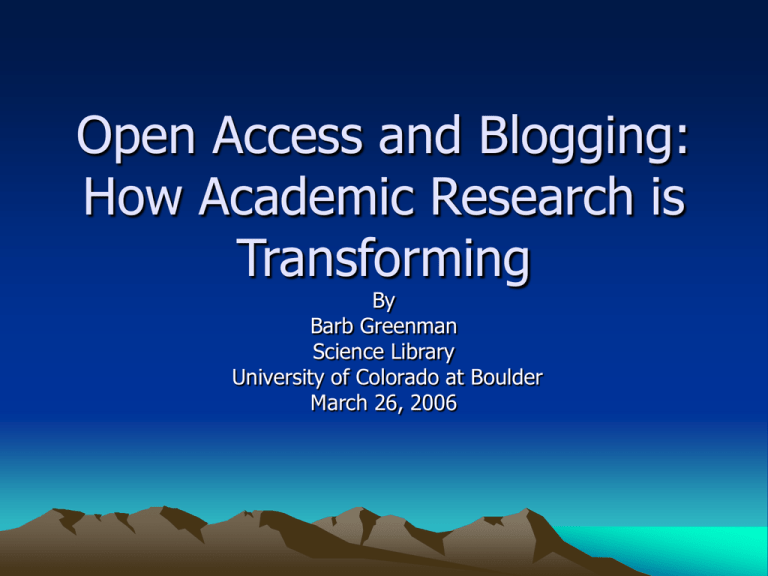
Open Access and Blogging: How Academic Research is Transforming By Barb Greenman Science Library University of Colorado at Boulder March 26, 2006 Transformation of Academic Research Scientific research is undergoing a phenomena that is reworking the very foundation of the research process itself, from start to finish. Core elements of this transformation include: open access and societal participation, i.e., weblogs Open Access (OA) Open-access (OA) literature is digital, online, free of charge, and free of most copyright and licensing restrictions. --Stuber, 2004 Factors Driving Transformation • Limited access to scientific research, although large % is publicly funded • Increase in scientific literature worldwide • Global push for OA • Decrease in budgets for scientific literature • Increase in public participation, blogs (ivory tower vs. “man in the street”), • Increase in institutional repositories/archives non-published research Funding--Scientific Research National Institutes of Health (NIH)--leading source of basic research funding $28 Billion ---Falk, 2004 US Gov. Universities Other 59% 29% 7% Patents and scientific papers 73% from governmental sources 27% from industrial scientists --Narin et al, 1997 OA-Publishing Models 1. Author fees-$300-$1500, quotes of $3000 2. Institutional fees-ex. BioMed Central $1550$7750 3. Optional fee structure-The Scientific World and Company of Biologists. author pays fee for OA author does not pay fee, no OA NIH Public Access to Archives Stable archive of peer-reviewed research publications resulting from NIH-funded research • Requests NIH-funded investigators to submit to the NIH National Library of Medicine’s PubMed Central • Copyright can be transferred by author to publisher • Submissions to their portal 0-12 mon. • Portal only receives articles authors chose to submit or that publisher allows them to submit • Article may be submitted to portal in some other form Open Access and the Notion of Public Good “Circle of Gifts” 1650’s two tenets: 1. Scholarship is a public good 2. Referring is critically important --Shulenburger 2005 “Public Goods and Open Access” Shulenburger, Provost Office University of Kansas (2005) – – – – – Copyright cannot be given permanently Journal rather than author submits to NIH portal Article deposited in 6 months Portal receives all articles published via NIH funding Portal receives article in form it was published. OA Issues • • • • • Costs—who pays? Peer-review concerns copyright Professional societies and revenues Lay public confusion in reading scientific research—Who should READ Science? OA Positives • Public Science--our society funds scientific research • Timeliness • Global community • Author visibility/impact • Freely accessible, archived, & searchable • Dissemination of information and data • Better access to ‘gray literature’ • OA and discovery/serendipity Weblogs or Blogs • Weblog is a website resembling a personal journal that is updated with individual entries or postings. • Blogs are time stamped and automatically archived. • RSS (Really Simplified Syndication) feeds are news channel summary of the blogs content. --Reichardt & Harder (2005) • 20 million+ blogs, sciences not well represented • Blogs are instantaneous publications Weblog Blogs, “…have developed beyond being digital ethnographers’ journals and into a hybrid between journal, academic publishing, storage space for links and site for academic discourse” --Mortensen & Walker (2002) Blogs “..offer fresh opportunities both before publication, when people are debating ideas and hypotheses, and after, when they are finding and discussing published results.” --Tomlin (2005) Blogging Culture Redefining Academic Discourse • Blogging won’t replace academic publishing, but allows for serious debate • Weblogs complement existing system of peer reviewed journals • Younger generation sees a benefit in blogging research ideas, less competitive and less confidential --Butler (2005) Continued: Blogging Culture Redefining Academic Discourse • Young scholars are already connected • Cross-blog discussions can turn traditional academic hierarchies topsy-turvy • Blogosphere provides an open forum where academics can reconnect with the public --Farrell (2005) • “…blogging is likely to become the social glue for thoroughly globalized communities.” --Nature Cell Biology Editorial Scholarly Blogs • Panda’s Thumb (evolution) http://www.pandasthumb.org/ • Pharyngula (evolution) http://scienceblogs.com/pharyngula/about.php • RealClimate (climate science) http://www.realclimate.org/ • Open Access News http://www.earlham.edu/~peters/fos/fosblog.html • Nature News Blog http://blogs.nature.com/news/blog/ • Chemical Network News (news & articles reviewed) http://www.chemical-network.com/ • The Scientist Blog (bioinformatics & biotech news) http://www.thescientistblogspot.blog.com OA & Blogs Scientific Communication • “Complexity of thought need not lead to impenetrability of expression” • “Improving the quality of writing actually improves the quality of thought.” --Gopen & Swan (1990) • “We need to exorcise the myth that, to write readably about science, authors have to write superficially or grossly simplify their subject.” --O’Donnell • “These are exiting times and troubling times as the nature of writing itself metamorphoses into an entirely different creature.” --Armstrong (2005) The Transformation to Public Science • Comprehensive OA networks or centers of excellence • Discipline based scholarly platforms ---Stern (2005) • Articles enhanced with explanatory links and informational sidebars --Gass • Hybrid models of publishing • Peer-review and non-peer review • Integration of databases • Access to data sets • Research process open to community discourse & discovery Conclusion With the advent of increased OA sources and weblogs, the structure of academic research and publishing has already begun to change. Utilizing the notion of the “public good” as a guiding principle, scientific research and communication will continue to evolve in conjunction with societal participation. References Antelman, Kristin. (2004). Do Open Access Articles Have a Greater Research Impact? College & Research Libraries, 65(2), 372-382. Armstrong, William. (2005). Communication in the Sciences as Seen Through Physics and Chemistry: A Look at the Complex Relationship between Author, Publisher, and Distributor as They Relate to the Reader. College and Research Libraries, 66(2), 98-114. Banks, Marcus. (2004). Connections Between Open Access Publishing and Access to Gray Literature. Journal of the Medical Library Association, 92(2), 164-166. Butler, D. (2005). Joint efforts. Nature, 438, 548. Editorial, (2006). Nature Cell Biology, 8(1), 1. Fallows, J. (2004, May 16, 2004). The twilight of the information middlemen. The New York Times, pp. 3.5. Farrell, H. (2005). The blogosphere as a carnival of ideas. Chronicle of Higher Education, 52(7), B14. Falk, Howard. (2004). Open Access Gains Momentum. The Electronic Library, 22(6), 527-530. References-Continued Gass, Andy and Doyle, Helen. (2005). The Reality of Open-Access Journal Articles. The Chronicle of Higher Education, 51(24), B13. Gopen, George D. and Swan, Judith A. (1990). The science of scientific writing: If the reader is to grasp what the writer means, the writer must understand what the reader needs. American Scientist, 78, 550. Mortensen, Torill and Walker, Jill. (2002). Blogging thoughts: Personal publication as an online research tool. In A. Morrison ed. (Ed.), Researching ICTs in context (1 ed.) (pp. 249). Oslo, Norway: InterMedia University of Oslo, Norway. Narin, F., Hamilton, K. S., & Olivastro, D. (1997). The increasing linkage between U.S. technology and public science. Research Policy, 26, 317-330. References--Continued O'Donnell, M. (2005). Scientific papers are not written to disseminate information. British Medical Journal, 330, 256. Reichardt, Randy and Harder, Geoffrey. (2005). Weblogs: Their use and application in science and technology libraries. Science and Technology Libraries, 25(3), 105. Shulenberger, D. E. (2005). Public goods and open access. New Review of Information Networking, 11(1), 3. Stern, D. (2005). Open access or differential pricing for journals: The road best traveled? Online, , 31. Suber, P. (2005). Journals' prices and open access to scholarly articles. The Chronicle of Higher Education, 51(14), B21. Tomlin, S. (2005). The expanding electronic universe. Nature, 438, 547.

